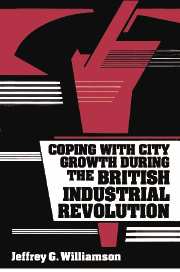Book contents
- Frontmatter
- Contents
- List of tables
- List of figures
- Acknowledgments
- 1 Coping with city growth, past and present
- 2 The urban demographic transition: Births, deaths, and immigration
- 3 Migrant selectivity, brain drain, and human capital transfers
- 4 The demand for labor and immigrant absorption off the farm
- 5 Absorbing the city immigrants
- 6 The impact of the Irish on British labor markets
- 7 Did British labor markets fail during the industrial revolution?
- 8 Did Britain's cities grow too fast?
- 9 City housing, density, disamenities, and death
- 10 Did Britain underinvest in its cities?
- References
- Index
7 - Did British labor markets fail during the industrial revolution?
Published online by Cambridge University Press: 03 May 2010
- Frontmatter
- Contents
- List of tables
- List of figures
- Acknowledgments
- 1 Coping with city growth, past and present
- 2 The urban demographic transition: Births, deaths, and immigration
- 3 Migrant selectivity, brain drain, and human capital transfers
- 4 The demand for labor and immigrant absorption off the farm
- 5 Absorbing the city immigrants
- 6 The impact of the Irish on British labor markets
- 7 Did British labor markets fail during the industrial revolution?
- 8 Did Britain's cities grow too fast?
- 9 City housing, density, disamenities, and death
- 10 Did Britain underinvest in its cities?
- References
- Index
Summary
Two competing views
Did factor markets fail during the British industrial revolution? Did distortions in capital markets serve to starve industrial firms for finance and suppress accumulation there? Did urban-rural wage gaps, inelastic city-labor supplies and lack of integrated labor markets serve to drive up the cost of labor in the cities, thus choking off the rate of industrialization? With regards to labor-market failure, the literature is of two minds.
Labor markets did fail
An extensive traditional literature takes the view that migrants were reluctant to move, wage gaps were large, and regional labor markets were fragmented.
A century ago, Earnst Ravenstein (1885, 1889) published his classic work on internal migration, subsequently augmented by Arthur Redford (1926) and Alex Cairncross (1949, 1953). Ravenstein asked how many migrated, when they migrated, who migrated, where they migrated from, and where they migrated to. The same questions dominate modern migration studies. Thus, for example, the literature has been busy substantiating Ravenstein's and Redford's observation that the majority of migrants went only a short distance, and often by steps. Such observations have encouraged the belief that workers failed to move to the highest wage areas and thus that the perfect labor-market thesis must fail.
There is an equally long tradition among British labor historians that there was a multiplicity of labor markets between 1750 and 1850, that regional labor markets were very poorly integrated, and that local autonomy reigned (Pollard, 1978).
- Type
- Chapter
- Information
- Coping with City Growth during the British Industrial Revolution , pp. 178 - 218Publisher: Cambridge University PressPrint publication year: 1990



